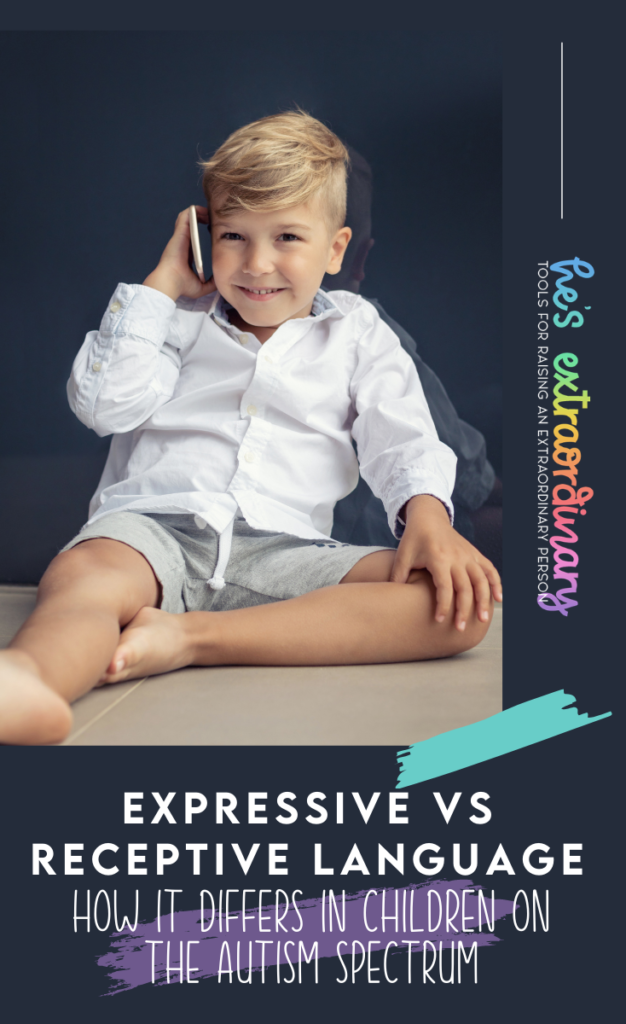Expressive VS Receptive Language
What’s inside this article: The meaning of both expressive language and receptive language, but how these skills can differ in children on the autism spectrum. Includes links to resources to help develop these skills.
If your child sees a speech-language pathologist or has had a psychoeducational assessment, you may have heard the terms expressive and receptive language thrown around a time or two.
In case you’re wondering what they both mean, and how they affect your child’s communication skills, I’m going to explain what expressive and receptive language are.
Language itself is how we communicate verbally (or written) with each other. But, this post focuses on verbal communication and the components of it.
During communication, we both send (express) and receive messages through a channel.
Expressive Language
Expressive language is language used to express ourselves. When it comes to verbal communication, expressive language is speaking.
However, it goes beyond just saying words and having a vocabulary. That is simply “speech production” which is a necessary building block of expressive language, but it’s more complex than that.
It’s about formulating thoughts and expressing them in a meaningful way that others can interpret and understand. Expressive language includes everything from sentence formation and pronunciation to tone, facial expressions, and inflection.
Expressive Language and Autism
It’s common for autistic children to have lagging communication skills.
Expressive language is so intricately connected to reading, writing, listening and comprehension, building relationships, and virtually every other component of day-to-day life.
That’s why it’s critically important to do everything you can to help your child develop adaptive language skills.
Read: 6 Tips for Improving Expressive Language in Autistic Children
Expressive Language for Parents
It’s equally important as parents to make sure we use clear expressive language when we speak to our children. As adults, we can understand our children’s varying communication skills.
So, meet your child on their level, and optimize your language, improving the communication process by making it easier for them to understand you.
Read: How to Optimize Your Language to Make it Easier to Communicate With Your Autistic Child
Receptive Language
Receptive language is the ability to understand the information. When someone talks to your child, do they understand the message?
This is more than just the ability to listen and repeat what they heard. Receptive language skills include understanding complex speech and instruction, knowing the intent and tone of a message, being able to organize and follow directions.
Receptive Language and Autism
Autistic children may have lagging receptive language skills.
If this is the case, you may notice your child responds incorrectly to questions. For example, if you say “how was your day?” they may respond by telling you what they did today.
They may need instructions to be given in 1 to 2 steps at a time so they can follow them. Or, they may misinterpret things you say to them.
You can help your child practice their receptive language skills with different types of listening activities and checking for comprehension.
You can also accommodate any challenges by providing visual supports, providing written instructions, and giving them extra processing time when you speak.
Read: 5 Ways to Improve Oral Language Comprehension

Development of Language Skills in Autistic Children
For a neurotypical child, all development is typically even and uniform across all developmental domains.
Basically, what that means is, as their language skills develop, all components of language would develop fairly evenly, along with cognitive development, social-emotional development, and physical development.
Children with autism, however, have an uneven development of skills. This means they could have exceptional abilities in some areas and lagging skills in other areas.
It’s important to keep this in mind because people often make assumptions that may be untrue for someone whose autistic.
The truth is it can be one way or another and it depends on the individual’s unique developmental profile.
Keep these differences in expressive and receptive languages in mind as you communicate with your child

